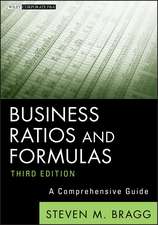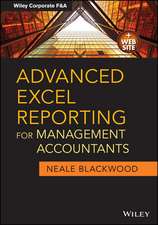Trends in managerial and financial accounting: Income determination and financial reporting: Nijenrode Studies in Business, cartea 1
Editat de Cees van Damen Limba Engleză Hardback – 31 iul 1978
| Toate formatele și edițiile | Preț | Express |
|---|---|---|
| Paperback (1) | 637.78 lei 6-8 săpt. | |
| Springer Us – 12 oct 2011 | 637.78 lei 6-8 săpt. | |
| Hardback (1) | 643.99 lei 6-8 săpt. | |
| Springer Us – 31 iul 1978 | 643.99 lei 6-8 săpt. |
Preț: 643.99 lei
Preț vechi: 757.63 lei
-15% Nou
Puncte Express: 966
Preț estimativ în valută:
123.24€ • 133.82$ • 103.52£
123.24€ • 133.82$ • 103.52£
Carte tipărită la comandă
Livrare economică 22 aprilie-06 mai
Preluare comenzi: 021 569.72.76
Specificații
ISBN-13: 9789020706932
ISBN-10: 9020706934
Pagini: 225
Ilustrații: XVI, 225 p.
Dimensiuni: 155 x 235 x 14 mm
Greutate: 0.52 kg
Ediția:1978
Editura: Springer Us
Colecția Springer
Seria Nijenrode Studies in Business
Locul publicării:New York, NY, United States
ISBN-10: 9020706934
Pagini: 225
Ilustrații: XVI, 225 p.
Dimensiuni: 155 x 235 x 14 mm
Greutate: 0.52 kg
Ediția:1978
Editura: Springer Us
Colecția Springer
Seria Nijenrode Studies in Business
Locul publicării:New York, NY, United States
Public țintă
ResearchCuprins
I. A synthesis of inflation accounting and replacement value accounting.- 1. Reporting to external users and for management.- 2. Comparison of inflation accounting and replacement value accounting.- 3. Evaluation of the two accounting methods.- 4. The objectives of financial statements.- 5. A proposal for a synthesis.- II. A study in current value accounting.- 1. Introduction: the ideal management information system.- 2. Current value, part of the system’s basic data.- 3. Purchases, sales and stock.- 4. Benefits from the use of current value.- 5. Simplification of the system.- 6. Summary and conclusion.- III. The primacy of accounting income in decisions on expansion: an exercise in arithmetic.- 1. Introduction.- 2. Valuing an expansion path.- 3. The relationship between current and economic income.- 4. The evaluation of expectations.- 5. Expansion-neutral income taxes.- 6. Conclusion.- IV. The cash flow accounting alternative for corporate financial reporting.- 1. Introduction.- 2. Challenges to date.- 3. The U.K. example.- 4. The conceptual argument.- 5. The measurement arguments.- 6. User comprehension.- 7. The future.- V. The rationale of cash flow accounting.- 1. Introduction.- 2. Cash flow accounting and shareholders.- 3. Return to shareholders.- 4. The determinants of dividend and retentions.- 5. Comparison with other accounting systems.- VI. The capital-income statement as a new tool for management.- 1. Introduction.- 2. A new statement to serve specific purposes.- 3. An application.- 4. Epilogue.- VII. The annual statement needs a theory.- 1. What does the annual statement aim at?.- 2. The annual statement lacks a theory of information.- 3. Two major conclusions.- 4. A reliable theory of information.- 5. The statement of income administration.- 6. Thestatement of income distribution.- 7. The statement of capital administration.- 8. The auditors’ certificate.- VIII. Accounting for the cost of interest.- 1. Accounting should adopt the concept of interest used in economics.- 2. Implications of the proposal.- 3. Harmonizing financial accounting and management accounting.- 4. Measuring interest cost.- 5. Accounting procedures.- 6. Effect on financial statements.- 7. Conclusion.- IX. Accounting principles that serve the information needs of corporate investors.- 1. Introduction.- 2. Valuation of an investor’s share.- 3. Estimating net present value.- 4. Corporate financial statements and share prices.- 5. Forecasting and the use of historical data.- 6. Historical and replacement costs in an inflationary environment.- 7. General price level adjusted historical cost (GPLAC).- 8. Conclusions.- X. Stock market efficiency and the information content of financial reports.- 1. Introduction: problem setting.- 2. The efficient market concept.- 3. How realistic is the concept?.- 4. A transparent stock market.- 5. Market efficiency, market transparency and the informational content of financial reports.- 6. Conclusions.- XI. Technical assumptions and review of financial forecasts.- 1. Introduction.- 2. Regulatory pronouncements on publication of financial forecasts.- 3. What is an assumption?.- 4. Scope of the study.- 5. Impact of technical assumptions on the bottom line.- 6. Interpretation of results.- 7. Which assumptions merit disclosure?.- 8. What can assumptions accomplish for the investor?.- Appendix A.- Appendix B.



















